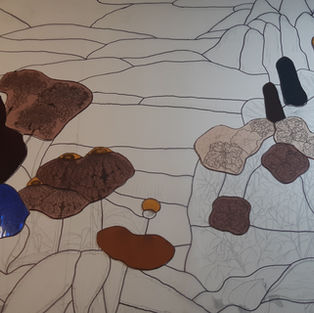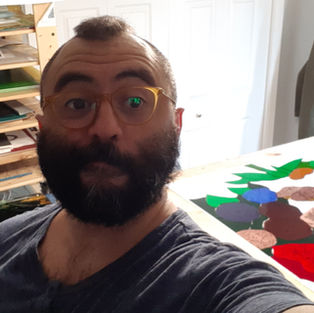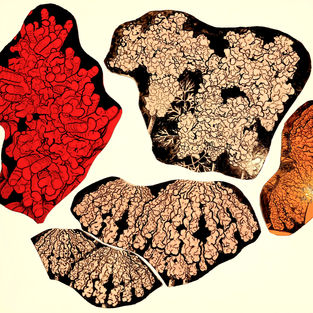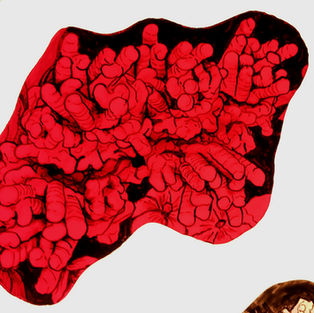A Walk in the Neuroscience Garden
Transparent stained glass (for paint), Reusche traditional stained glass colours, Youghiogheny opalescent glass, lead came (4 sizes), zinc reinforcing bars, lead.
127 x 102 cm (40 x 50 in)
2022 - Longueuil, QC, Canada

Artist statement
A Walk in the Neuroscience Garden
"A Walk in the Neuroscience Garden" is a mix-media stained glass panel assembled in lead came. The piece combines three layers of traditional Reusche stained glass colours independently fired on transparent glass at ~680°C (1250 °F) and luxurious Youghiogheny opalescent glass to create a pastoral scene.
The piece depicts an Eastern Canadian garden (Quebec) where hydrangeas, hollyhocks, cosmos, hostas, wild gingers, echinaceas, lupins, Queen's Anne lace wild carrots, and pigweeds are painted in transparent glass. Complementing the paintings, a pond, trees, hills, mountains, and clouds in opalescent glass to create a pastoral scene inspiring abstraction and inviting the viewer into a deeply relaxing state.
The owners of the artwork are nature lovers as well as neuroscientists. Compelling me to create flowers from a structural representation of different proteins involved in vital neuroscience processes. Lupins became SNARE complexes (VAMP, SNAP25 and Syntaxin 1A) that drive the fusion of vesicles loaded with neurotransmitters. Echinacea petals became Netrin-1 proteins, crucial in axon guidance. And while hollyhocks are bundles of Glutamate AMPA receptors 2/3, cosmos became voltage-gated Calcium-activated Potassium channels BK. Queen's Anne lace became voltage-gated Sodium channels, and hydrangeas turned into bubbles of MscL (Large Conductance Mechanosensitive Ion Channel) ion channels in bacteria. As a group, these molecules sample early and late stages in the evolution of some of the most iconic proteins involved in neuronal communication, guidance, and electrical tunning in cells.
The structures were collected from the Protein Data Bank (PDB) website of three-dimensional structural data of large biological molecules, such as proteins and nucleic acids. Submitted by structural scientists worldwide, the PDB database gathers structures resolved by X-ray crystallography, NMR spectroscopy, and cryo-electron microscopy. The PDB is free to access and is overseen by the Worldwide Protein Data Bank, wwPDB.
Each molecule was worked in a free visualization software provided by the PDB to set the proper perspective to emulate the flowers they would replace in the scene.
"A Walk in the Neuroscience Garden" is an ode to the beauty of our natural world, from visible to invisible. A reminder that we walk in gardens sensed by our brain using a concert of marvels that live inside us but usually keep hidden until science reveals them to us. There is beauty everywhere you look.






Process
Click on the pics to learn more
A Walk in the Neuroscience Garden
Transparent stained glass (for paint), Reusche traditional stained glass colours, Youghiogheny opalescent glass, lead came (4 sizes), zinc reinforcing bars, lead.
127 x 102 cm (40 x 50 in)
2022 - Longueuil, QC, Canada
























